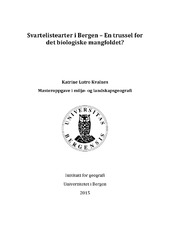| dc.description.abstract | The subject of this Masters thesis is alien species; a topic of increasing debate within the field of biogeography in recent years. Alien species are species that, aided by human activity, are able to spread beyond the natural extent of their habitats. These species play different roles within their adopted ecosystems; some complement the naturally occurring flora and fauna while others dominate and out-compete it leading to a loss in biodiversity. In the latter case the alien species is referred to as invasive. The aim of this thesis has been to study three black-listed, alien species in the wider Bergen area as well as one red-listed native species. The three black-listed species are Japanese knotweed (Reynoutria japonica), Giant knotweed (Reynoutria sachalinensis) and Giant hogweed (Heracleum mantegazzianum). The red-listed species is Masterwort (Peucedanum ostruthium). A theoretical framework for the thesis is provided in Chapter 3. This includes the themes of biological diversity, the definition of invasive species (both native and alien) and the concept of biological invasion and factors determining its success. Three sources have been used in this study. The first is a collection of maps produced by the author from GPS data gathered during fieldwork and processed with GIS. These maps show the current extent of the four species within the area of study. The second source is the national database for species data Artsdatabanken. Comparing the historical database data with the new fieldwork data allows for a (limited) evaluation of the spreading of the four species over time. The third source of information for this study is a series of interviews with stakeholders from the spheres of public administration and academia. Their different, and at times conflicting, opinions are compared and contrasted. The Discussion chapter considers the types of habitats where the species have most successfully established themselves and whether the black-listed species should be considered an invasive threat to the study area. One of the main finds is that they haven't established themselves in areas of natural vegetation, despite having been present in the area for a long time. Furthermore, the distinction between red-listed and black-listed species is considered and its practical implications. Drawing on the interview material, the actions and opinions of the different stakeholders are compared to the theoretical framework. Another of the main finds of the study is that the interviewee from academia is more interested in why the species spread whereas the others are focused on how to tackle this spreading. | en_US |
